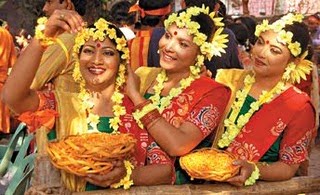In other celebrate the pahela Baishakh in a beffiting manner we decorated the school premises tastefully. So the school wore a festive look. There were some groups of volunteers who extended their helpful hands in various activities for celebrating the mela arranged on the occasion. One group fenced the entire area. Another group set up shops and stalls for the traders. There were shops of nick nacks, sweets, toys and homemade things. Another group of volunteers rendered service in maintaining discipline. The mela became the place of get- together for the people of the nearby villages. The fair was a special attraction for the children. They bought toys, sweets and different types of things. Since I was one of the organisers of the mela, I was preoccupied to make the mela a success. In fact the mela gave me immense pleasure because all my efforts became succesfull.
Pohela Falgun And Boishakh


Sunday 6 February 2011
Saturday 5 February 2011
Celebrating the First Day of Bangla New Year

Monday 31 January 2011
Pohela Falgun And Boishakh
Pohela Falgun
 The name Falgun came from the star Falguni. The reason behind the naming after starts is that in the Vedic Age (1500 BC) the rishis (ancient Indian scholars) had an obsession with astrology and the stars. Though they use to follow the solar year the mention of Falguni (spring) full moon in Vedic Literature suggests that lunar months were also calculated. Probably the traditional inclination of the rishis to the moon and stars led to the naming of the months after stars.
The name Falgun came from the star Falguni. The reason behind the naming after starts is that in the Vedic Age (1500 BC) the rishis (ancient Indian scholars) had an obsession with astrology and the stars. Though they use to follow the solar year the mention of Falguni (spring) full moon in Vedic Literature suggests that lunar months were also calculated. Probably the traditional inclination of the rishis to the moon and stars led to the naming of the months after stars.  The significance of Pohela Falgun is very singular in our national life. The way we celebrate Pohela Boishakh and Pohela Falgun in Bangladesh these days started to flourish after the arousal of Bengali Nationalism in 1950s and 1960s.
The significance of Pohela Falgun is very singular in our national life. The way we celebrate Pohela Boishakh and Pohela Falgun in Bangladesh these days started to flourish after the arousal of Bengali Nationalism in 1950s and 1960s. “Pohela Falgun” symbolizes the festival of color, coherence of heart and a refreshing start of life. Nature, that seemed decayed recently, suddenly appears with full of infancy. Nature becomes colorful as flowers like Shimul, Polash, Mango, Rose, Marigolds blossom. Melody of birds or mild touch of the sunshine – everything will make you feel that springtime is the nature’s festival. The day will inspire you to fall in love, to be romantic.
On the occasion, girls are dressed in bashonti (yellow or orange) coloured saree and flowers in hair while boys wear colorful pajama and panjabi to welcome the arrival of spring
Pohela Boishakh
 New Year's festivities are closely linked with rural life in Bengal. Usually on Pohela Boishakh, the home is thoroughly scrubbed and cleaned; people bathe early in the morning and dress in fine clothes. They spend much of the day visiting relatives, friends, and neighbours. Special foods are prepared to entertain guests. This is one rural festival that has become enormously big in the cities, especially in Dhaka.
New Year's festivities are closely linked with rural life in Bengal. Usually on Pohela Boishakh, the home is thoroughly scrubbed and cleaned; people bathe early in the morning and dress in fine clothes. They spend much of the day visiting relatives, friends, and neighbours. Special foods are prepared to entertain guests. This is one rural festival that has become enormously big in the cities, especially in Dhaka. Observance of Pohela Boishakh has become popular in the cities. Early in the morning, people gather under a big tree or on the bank of a lake to witness the sunrise. Artists present songs to usher in the new year. People from all walks of life wear traditional Bengali attire: young women wear white saris with red borders, and adorn themselves with churi bangles, fultip (bindis). Men wear white paejama (pants) or lungi(dhoti/dhuti) (long skirt) and kurta (tunic). Many townspeople start the day with the traditional breakfast of panta bhat (rice soaked in water), green chillies, onion, and fried hilsa fish. flowers, and
Observance of Pohela Boishakh has become popular in the cities. Early in the morning, people gather under a big tree or on the bank of a lake to witness the sunrise. Artists present songs to usher in the new year. People from all walks of life wear traditional Bengali attire: young women wear white saris with red borders, and adorn themselves with churi bangles, fultip (bindis). Men wear white paejama (pants) or lungi(dhoti/dhuti) (long skirt) and kurta (tunic). Many townspeople start the day with the traditional breakfast of panta bhat (rice soaked in water), green chillies, onion, and fried hilsa fish. flowers, and
Subscribe to:
Posts (Atom)
Gallery

bangladeshi Girl 01

pohela Falgun 01

Falgun

